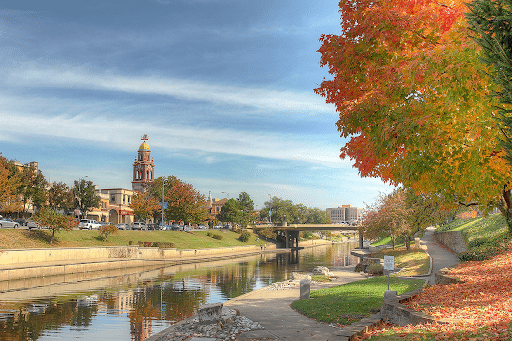Those of a certain age are familiar with the Western Heritage Award-winning TV series Rawhide. Every Friday night for six years, a crew of seasoned cowboys drove herds of Texas cattle toward the railhead at Sedalia, Missouri.
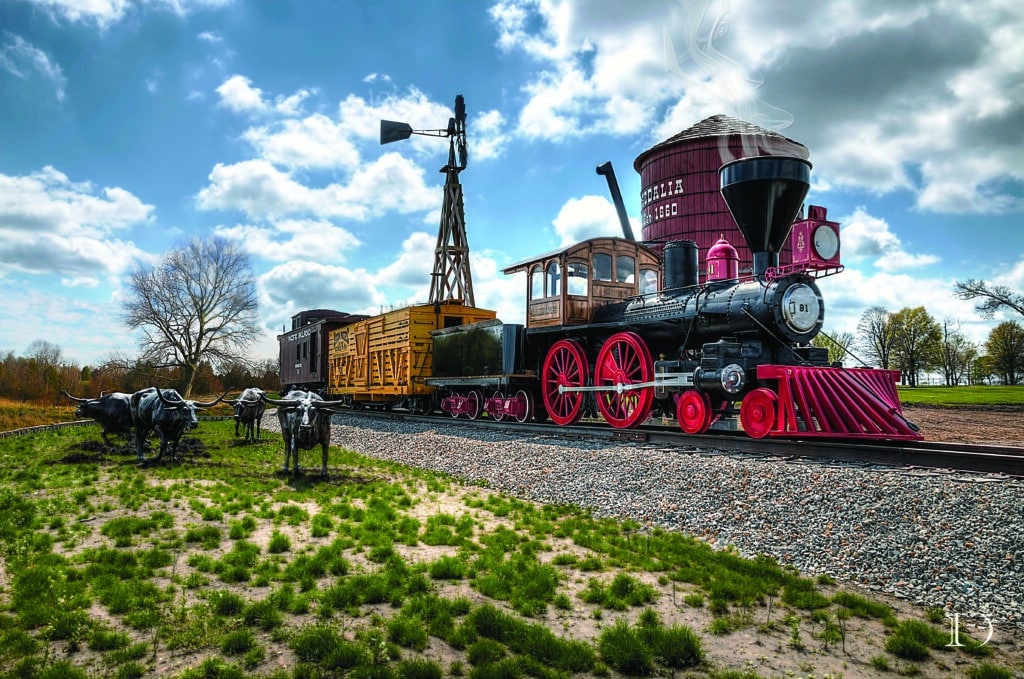
The Trail’s End art installation at the Missouri State Fairgrounds is an ambitious multi-sculpture depiction commemorating the grueling 19th-century cattle drives that brought the animals to Sedalia’s railroad terminal. This year, a sculpture of an American Indian scout will be added to the scene.
By Ron Soodalter
“Oh, come take up your cinches, come shakes out your reins;
Come wake your old bronco and break for the plains;
Come roust out your steers from the long chaparral,
For the outfit is off to the railroad corral.”
—Traditional Cowboy Poem (anonymous)
Rawhide represents one of the rare times when the storyline of a western is based on historical fact. Sedalia was the first real cowtown, and Missouri’s influence on America’s cattle business was destined to last for generations.
A FORTUNE IN WILD LONGHORNS
When the Civil War ended in 1865, Texas was in an economically depressed state and had around five million longhorn cattle roaming wild. Steers were worth no more than four dollars a head in Texas, but the rest of the nation was clamoring for beef. The market price in Chicago stood a staggering (for that time) $40 per steer. The challenge lay in delivering the ill-tempered beasts to market.
Since there were no railroads at the time linking Texas to either the north or the east, the herds had to be delivered the old-fashioned way—driven by riders on horseback over countless miles to a city or town with a railroad. And so were born the legendary cattle drives of the late 19th century.
In fact, there had been cattle drives to Missouri well before the Civil War. Starting as early as 1836—the year Texas won her independence—and continuing over the next two decades, Texans followed routes such as the Shawnee Trail, driving their wild mustangs and longhorn cattle to Sedalia, Independence, Boonville, and Lexington.
But these pre-war drives were small in comparison to the vast numbers of steers that would follow. In 1866 alone, 260,000 temperamental, slab-sided longhorns were driven up the Sedalia Trail to Missouri. And over the next 20 years, an estimated 20 million “beeves” left Texas for points north.
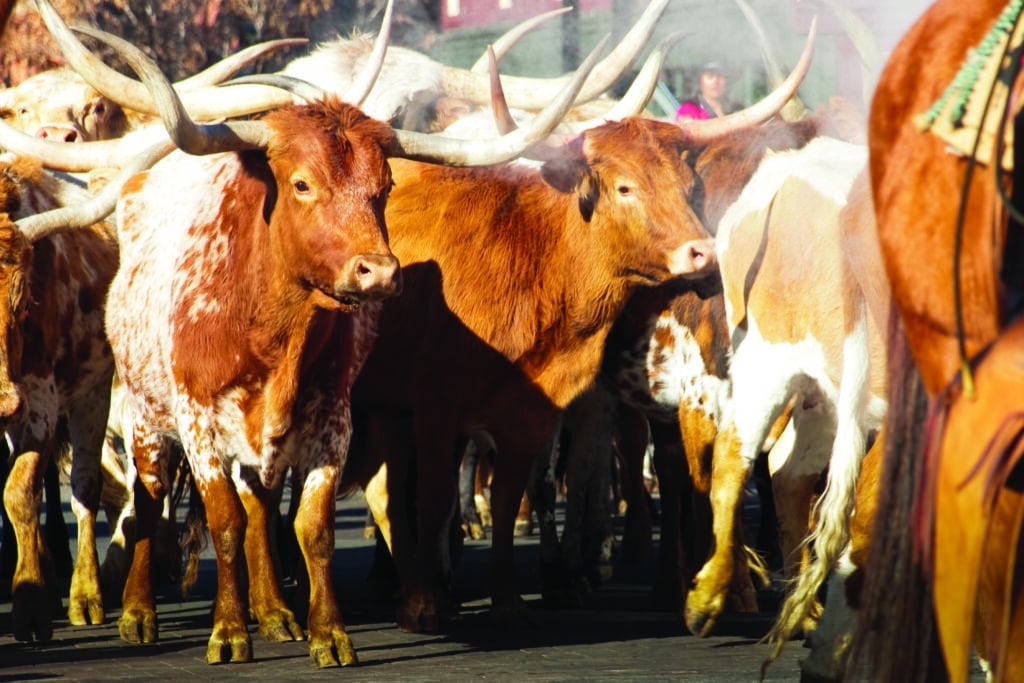
After the Civil War, longhorn steers—abundant and relatively worthless in Texas—were driven to Sedalia then transported by railroad to hungry customers in the east.
Despite what television and the movies would have us believe, life on the trail was far from romantic. The drives demanded resilience. Although shootings were rare, there was no shortage of ways in which a cowboy might perish.
There was the ever-present threat of Indians, who resented the seemingly endless parade of cattle crossing what had long been their tribal lands. More frequently, however, cowboys died on the trail as a result of being struck by lightning, dragged by a horse, or drowned in one of the many rivers they had to cross. Pneumonia claimed drovers’ lives as a result of working and sleeping in the rain, and infection, which was little understood at the time, claimed its fair share of young lives.
Not every calamity was fatal. Historical accounts from cowboys revealed that what didn’t kill them often just hurt like hell. Weeks and months spent in the saddle in wet and dry weather, as well as a steady diet of fried bacon and beans (“Pecos strawberries”), frequently resulted in a bad case of hemorrhoids. Don’t look for an admission in the annals of drover recollections; there were some things a cowboy simply didn’t share. Water was often hard to come by on the trail, and although daily bathing was not the practice anywhere in this time and place, life on the trail made personal hygiene virtually impossible. Cowboys were dirty, and they smelled of cows, and worse.
And yet, despite the dangers, the discomfort, the monotony, the slow pace, and recalcitrant cows, there was no lack of boys and young men eager to sign or make their mark for what they envisioned as the adventure of a lifetime. With the millions of cows being driven north, there was always a job waiting for them. And after their herds were delivered, many of them signed on for the next long drive, and the next. Despite the hazards and hardships, the rugged life of a cowboy was a dream job.
THREE MONTHS ON THE TRAIL
One after another, as the railroad moved ever farther west, the destination towns, or “railheads,” became legendary in their own right. Thanks in large part to Hollywood, when we think of the big cattle drives of the late 1800s, it is generally such end-of-trail towns as Abilene, Wichita, and most especially, Dodge City, that come to mind. But before the cattle were driven to the rowdy towns of Kansas, Sedalia was the destination of the large Texas herds.
The trailing distance from Austin, Texas, to Sedalia was roughly 720 miles, and the drive took a crew of 11 or 12 drovers some three months, averaging a dusty mind-numbing eight miles a day. When they arrived, they found that Sedalia was well up to the task of handling their large herd, and many more besides. A combination of good planning, location, and the arrival of the railroad had made it an ideal destination for the big herds.
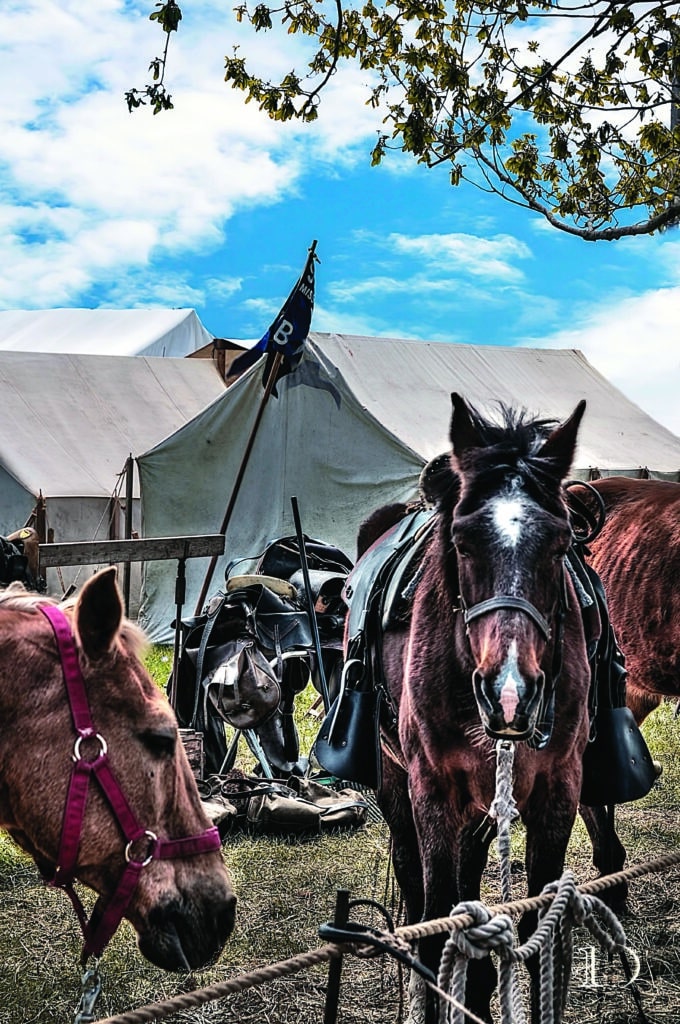
Horses await the action at a reenactor encampment in Sedalia. Few cowboys would have enjoyed the comfort of a tent during their trail journey, and many used a “Tucson Bed,” meaning their back was the bed and their belly was their blanket.
The land that would become Sedalia was originally the home of the Osage and Shawnee tribes. Then, in 1857, a native Virginian named George Rappeen Smith purchased and platted some 500 acres, calling it Sedville, after his daughter’s nickname, Sed. He offered parcels of his land at $75 a lot, for a town that didn’t exist. And, in fact, although he erected a sawmill in anticipation of a building boom, for nearly three years the land remained much as it had been when it was occupied by the Indians.
Smith, however, was a true visionary; he predicted the coming of the railroad and lobbied hard to make his prophecy reality. Indeed, due to his efforts, by the end of 1860 the almost-town that had been renamed Sedalia became the terminus of the Missouri Pacific Railroad, and shortly thereafter, headquarters of the Overland Stage Line.
By this time, the tracks had been laid, most of the lots sold, and buildings erected. These included a store, post office, and two hotels. As Smith had predicted, the beginning of 1861 saw the first passenger train steaming through Sedalia, carrying not only people but also goods, which were purchased and hauled west by wagon along the Santa Fe Trail. The town burgeoned and soon boasted grocery markets, a blacksmith, saddle and harness shops, druggists, and dry goods and general stores.
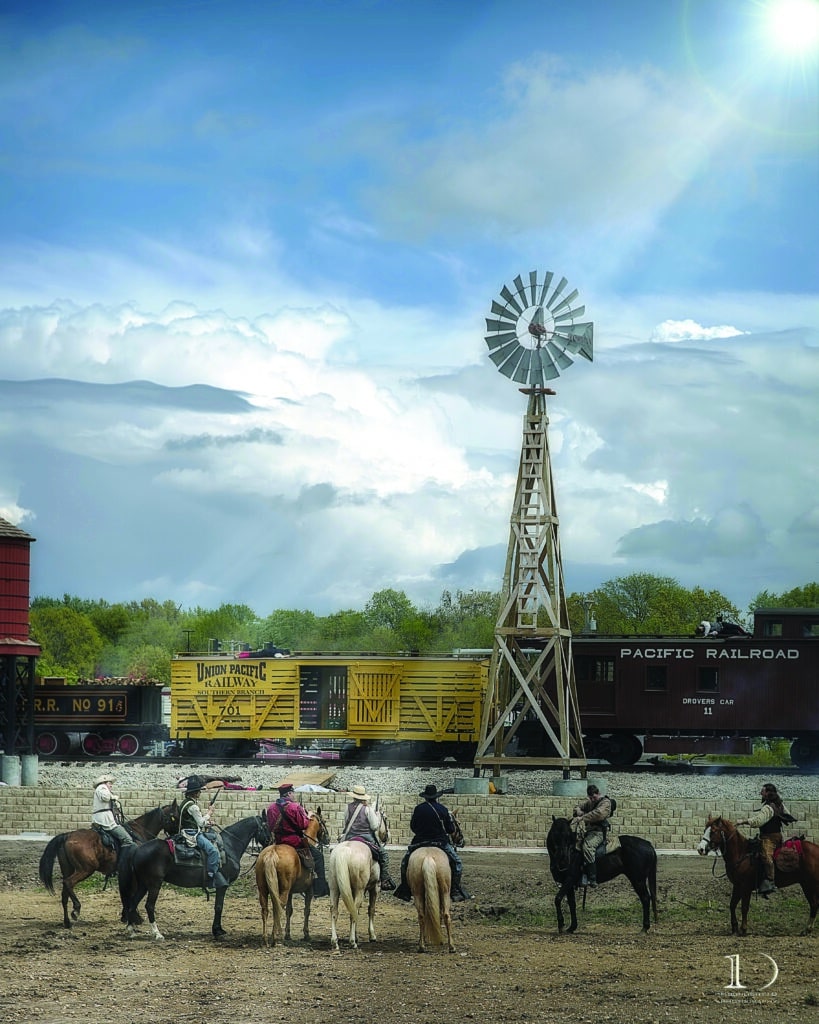
Reenactors on horseback provide a glimpse of Sedalia’s past.
The Civil War broke out that same year, and given Missouri’s position as one of the so-called Border States during the conflict, Sedalia—and its railroad—became the focus of both Union and Confederate troops. The sympathies of the residents of the city itself, which became the seat of Pettis County in 1864, were divided. As Sedalia historian Becky Imhauser eloquently put it, “The war turned Sedalia’s focus from settling to survival, from building to bushwhackers.”
The end of the war saw the addition of a newspaper, the Sedalia Weekly Times, operating in time to note the arrival of the first herds of Texas longhorns. The city built stockyards accordingly, to contain the countless thousands of steers. As the railroad’s cattle cars filled, Sedalia began to reap the benefits of the cattle trade, while the cowboys enjoyed the dubious benefits of the town’s drinking, gambling, and prostitution establishments.
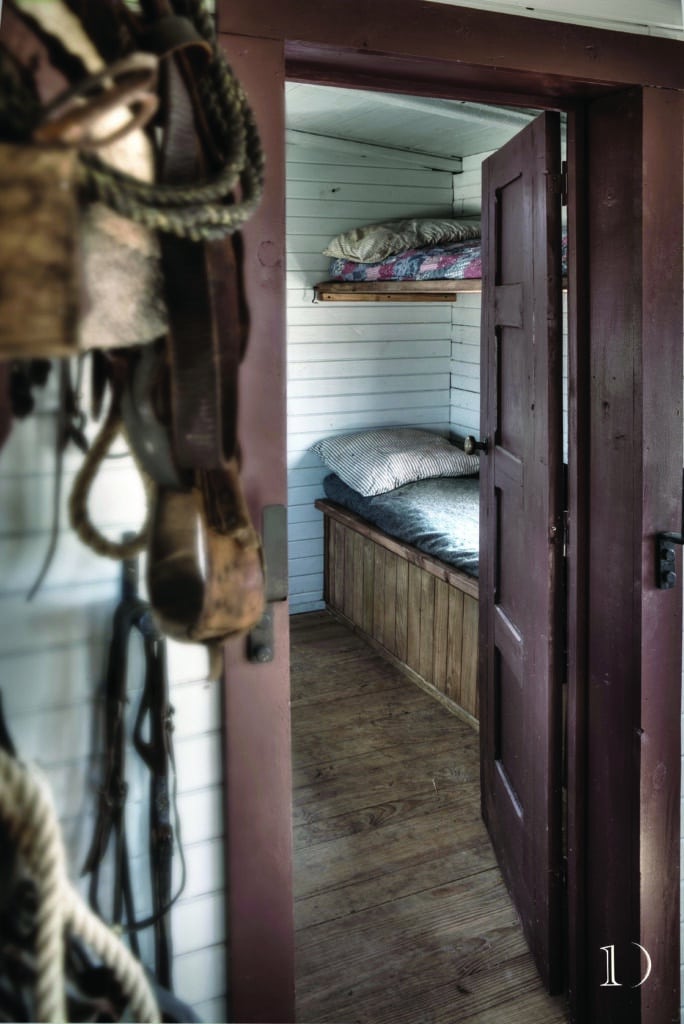
Visitors to Trails End can climb aboard the train and peek inside an authentic bunk room. Cowboys and sometimes the ranchers themselves would ride the trains to keep watch on the cattle.
It was not destined to last. By 1867, the Texas herdsmen had discovered the more easily passable Chisholm Trail, which took them directly to Abilene, Kansas, and the Kansas Pacific Railroad. The trailheads would soon move to other Kansas towns along the tracks, progressing from one to another—Ellsworth, Wichita, Dodge City, Caldwell—as the railroad stretched ever farther westward. Sedalia’s year as the main destination of the big trail herds was over.
There was another reason the cows were diverted to Kansas. When the vast herds of cattle first reached Sedalia, they carried with them Texas Fever. This highly contagious disease, transmitted by ticks, posed a serious threat to the local livestock. The Missouri legislature passed a strict law setting up a Board of Cattle Inspectors in each county to control the movement of Texas cattle. Ultimately, the herds were only allowed entry into Newton County, in the southwest corner of the state, and its railroad depot. The disease soon became Kansas’s problem, as the herds were driven to the railroad towns of Missouri’s more forgiving neighbor.
Interestingly, although she lost her status as the primary railhead for the Texas herds, Sedalia would continue to grow and prosper and would soon acquire another, less enviable kind of reputation. The gambling houses and brothels didn’t disappear with the cattle drives, but rather grew in such profusion that within a decade, the St. Louis Post-Dispatch would refer to Sedalia as the “Sodom and Gomorrah of the Nineteenth Century.”
FROM THE BOTTOMS TO THE TOP
Missouri still had a viable future in the cattle business, however. As impressive as was the volume of cattle that passed through Sedalia in her brief year as reigning queen of the trail drives, it paled in comparison to the stunning numbers of cattle that would ultimately be received and processed by the storied Kansas City Stockyards.
As the first herds arrived at the railheads of the late 1860s, cowboys prodded them into the railroad’s cattle cars to be delivered to the slaughterhouses and processing plants of Chicago. That city had built itself into the nation’s largest receiver and processor of livestock, but it would soon be sharing its business with an upstart operation in Kansas City, Missouri.
As events would soon prove, Kansas City was ideally placed as a central location between the western and southwestern cattle ranches and the livestock markets of the east. In 1870, a small group of entrepreneurial eastern tycoons and railroad executives purchased and fenced off five acres near the Missouri River, in the section of Kansas City known as West Bottoms. They built a handful of livestock pens on the property. The following year, they added another 13 acres along the Kansas River. This was the humble beginning of the Kansas City Stockyards.
Eastern investors gave the stockyards the incentive and the financing to expand, and over the next few years, the yards were penning a rapidly increasing number of animals. Then came the packing houses. With such modern developments as the refrigerator car, which enabled the quality-controlled shipment of dressed beef, the eastern meat packers realized the benefits of having plants in Kansas City that could directly receive the cattle, rather than paying the high charges to have them shipped east for processing. The cattle could be slaughtered, dressed, and packaged for shipment, all within the Kansas City complex. Philip Armour, followed by Swift, Wilson, and Cudahy—the so-called “Big Four”—built packing plants, and the Stockyards burgeoned.
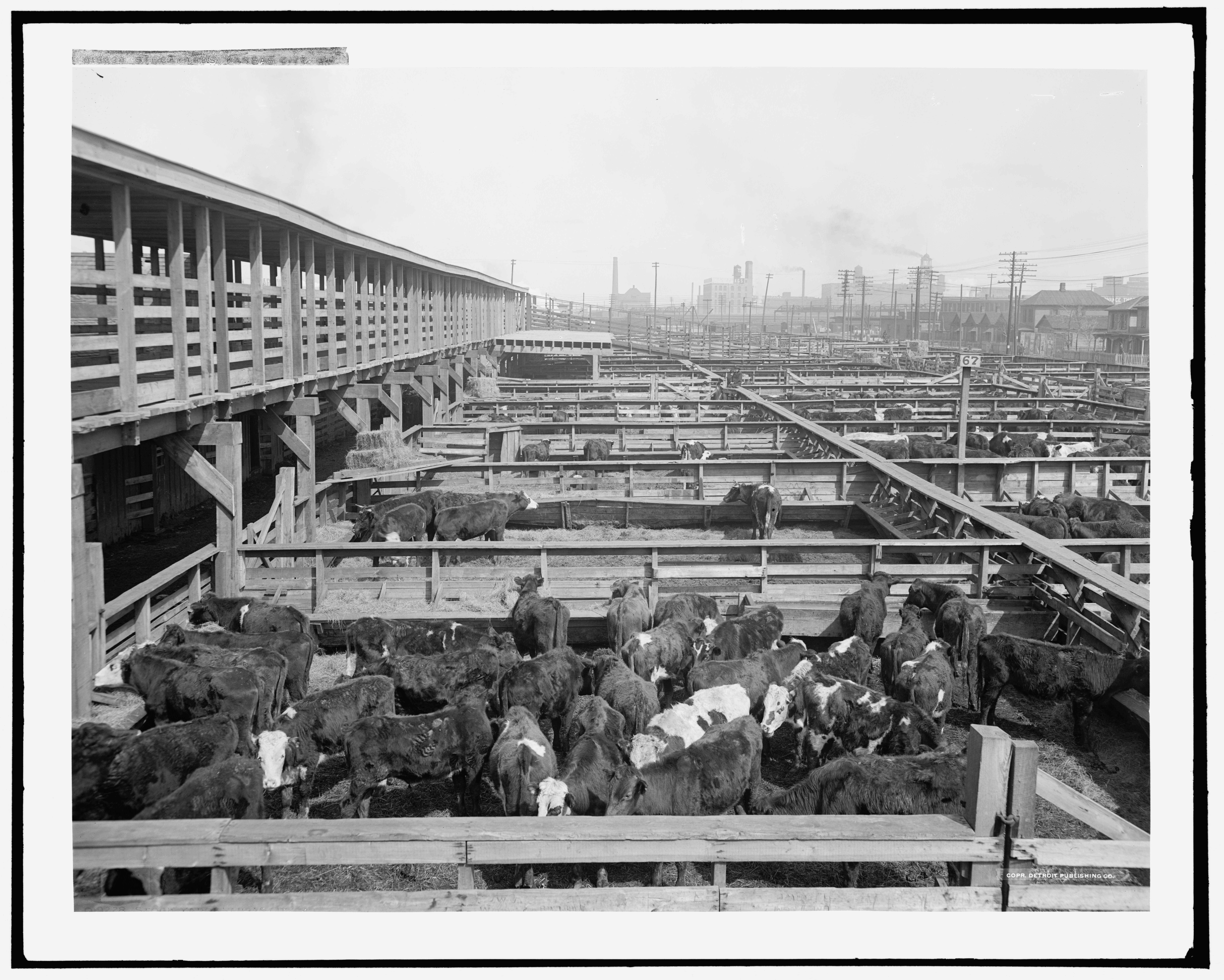
For more than A century, the Kansas City Stockyards penned, processed, and shipped millions of cows.
The growth of the Kansas City Stockyards was nothing short of phenomenal. The population, which stood at fewer than 5,000 residents in 1860, exploded with the coming of the Stockyards and the city’s development as a major transportation hub. By the turn of the century, Kansas City was home to around 160,000 people.
By the end of World War I, the Stockyards were penning nearly 500,000 head of cattle in a single month. In addition to the cattle, the yards also contained hogs, horses, and sheep. In all, more than 3.3 million animals were penned in the yards during the fall of 1918. By this time, there were 34 railroads servicing Kansas City’s meat industry, carrying animals into the city and dressed beef out. The yards occupied 230 acres, containing pens, packing plants, and related businesses. By this time, the Kansas City Stockyards, known familiarly as “Cowtown,” was second only to Chicago as the largest meat processing center in the country, employing 20,000 workers, which was around 70 percent of Kansas City’s entire workforce.

At its height, the expansive Kansas City Stockyards employed 70 percent of the city’s workers.
Working conditions for many of these laborers were poor, however, and the pay was low. Starting in the 1890s and continuing well into the 20th century, the plants were rocked by a series of worker strikes, walkouts, and sit-downs, encouraged and supported by the arrival of the unions. For decades, the two sides—labor and management—worked to find a tenable solution to the age-old problem.
There were other issues besides labor relations. As it turned out, the location was prone to flooding, and in 1917, a fire raged through the yards. Nonetheless, business continued apace until late 1991, when the last cow was auctioned off.
According to The Kansas City Star, rising costs and “changing agricultural marketing patterns” were the reasons the Kansas City Stockyards was shuttered after a 120-year run. In its day, the enterprise was legendary and a leader in the process of putting meat on America’s tables.
Today, the Stockyards District thrives with galleries, artists’ studios, businesses, and restaurants. One of the most impressive structures is the renovated Livestock Exchange Building, which houses dozens of businesses and studios and perhaps a ghost or two from the days when Kansas City truly earned the name Cowtown.
The West Bottoms Revival
Kansas City’s West Bottoms District is haunted—or at least it offers three haunted houses that thrill visitors every fall. There’s the Macabre Cinema, the Edge of Hell, and the largest of them all: The Beast. To say that the re-invented West Bottoms area of Kansas City is thriving is to grossly understate; it is, in fact, burgeoning.
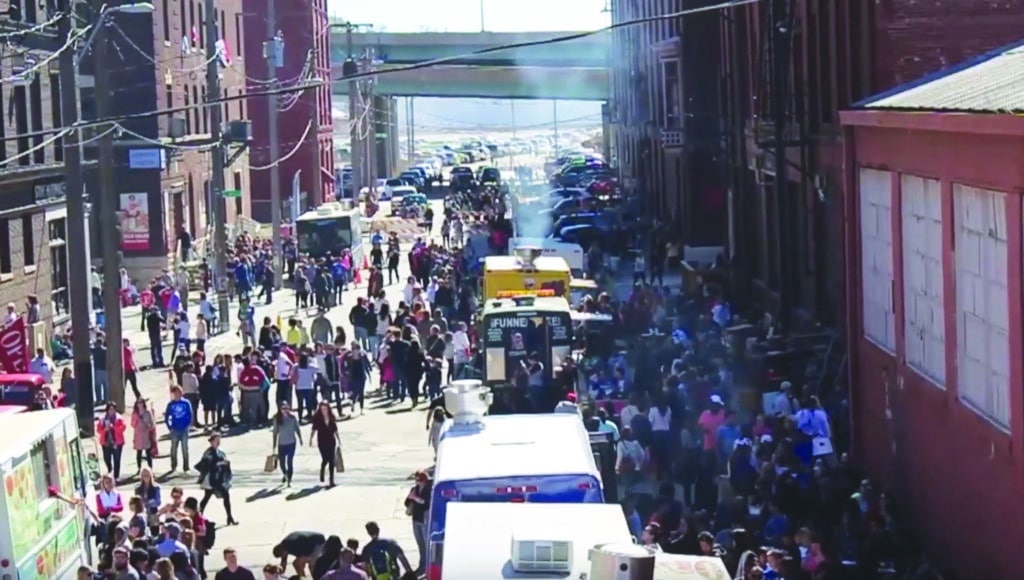
The revived West Bottoms area caters to shoppers and art lovers.
West Bottoms offers visitors plenty of entertainment options, from the Boulevardia Street Festival in June (happening June 15 and 16 this year) to the First Friday Weekends throughout the year, the Bottoms Car Shows, and the Mardi Gras 5K Run. The neighborhood boasts an array of shops, galleries, restaurants, and antiques emporia. Many, if not most, are housed in buildings from another era. Rather than razing the area’s classic 150-year-old warehouses and factories, their owners have opted to restore and revitalize them.
These Victorian survivors line the streets, offering a heady combination of old and new. The Rumely Event Space is a perfect example. Located in the West Bottom’s 12th Street Bridge district, it was constructed in the 1880s as the Advance-Rumely Thresher Company. It recently underwent two years of renovation that, according to the venue’s website, “make it a seamless combination of historic architecture with modern convenience and enduring elegance.”
The West Bottoms has come a long way from its 1870 beginnings as a livestock pen to its present state. The renovation began in the early 1990s, and with a combination of government and private funding, it has become a destination worth the drive.
For another Missouri cattle-related story—plus a tasty steak recipe!—click here.
Article originally published in the June, 2023 issue of Missouri Life.
Related Posts
Kansas City Blues was Founded
On January 26, 1924, the National Football League franchised the team farthest west of all their teams, the Kansas City Blues.
Kansas City Kings
November 10, 1974 is the first game of the NBA Kansas City Kings
How We Do Kansas City
Get in on what we’ve known all along. Kansas City is a city of champions.



